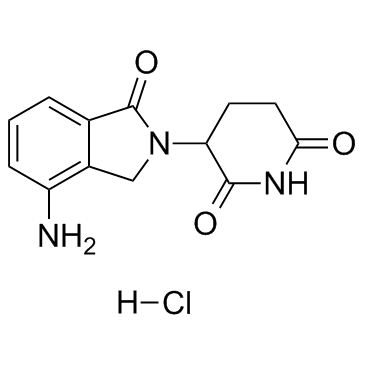1243329-97-6
| Name | (RS)-3-(4-amino-1-oxo-1,3-dihydroisoindol-2-yl)piperidine-2,6-dione hydrochloride |
|---|---|
| Synonyms |
3-(4-amino-1-oxo-1,3-dihydro-isoindol-2-yl)piperidine-2,6-dione hydrochloride
lenalidomide hydrochloride Lenalidomide (hydrochloride) |
| Description | Lenalidomide hydrochloride is a potent inhibitor of TNF-α and has antiangiogenic effect. Lenalidomide functions as a protein homeostatic modulator (PHM) linking casein kinase 1A1 (CKIα) to the human E3 ligase cereblon. |
|---|---|
| Related Catalog | |
| Target |
TNF-α[1] |
| In Vitro | Lenalidomide is potent in stimulating T cell proliferation and IFN-γ and IL-2 production. Lenalidomide has been shown to inhibit production of pro inflammatory cytokines TNF-α, IL-1, IL-6, IL-12 and elevate the production of anti-inflammatory cytokine IL-10 from human PBMCs. Lenalidomide downregulates the production of IL-6 directly and also by inhibiting multiple myeloma (MM) cells and bone marrow stromal cells (BMSC) interaction, which augments the apoptosis of myeloma cells[2]. Dose-dependent interaction with the CRBN-DDB1 complex is observed with Thalidomide, Lenalidomide and Pomalidomide, with IC50 values of ~30 μM, ~3 μM and ~3 μM, respectively, These reduced CRBN expression cells (U266-CRBN60 and U266-CRBN75) are less responsive than the parental cells to antiproliferative effects Lenalidomide across a dose-response range of 0.01 to 10 μM[3]. Lenalidomide, a thalidomide analog, functions as a molecular glue between the human E3 ubiquitin ligase cereblon and CKIα is shown to induce the ubiquitination and degradation of this kinase, thus presumably killing leukemic cells by p53 activation[5]. |
| In Vivo | The toxicity of Lenalidomide doses up to 15, 22.5, and 45 mg/kg via IV, IP, and PO routes of administration. Limited by solubility in our PBS dosing vehicle, these maximum achievable Lenalidomide doses are well tolerated with the exception of one mouse death (of four total dosed) at the 15 mg/kg IV dose. Notably, no other toxicities are observed in the study at IV doses of 15 mg/kg (n=3) or 10 mg/kg (n=45) or at any other dose level through IV, IP, and PO routes[4]. |
| Cell Assay | Cell lines NCI-H929 and U266, and DF15 cells are grown in RPMI-I640 medium containing 10% (V/V) heat-inactivated fetal bovine serum supplemented with 2 mM glutamine. To produce Lenalidomide resistant cell lines, NCI-H929 cells are treated continuously (fresh Lenalidomide is added every 3-4 days) with control (final 0.1% DMSO) or low-dose Lenalidomide (1 μM) for 2 months until the proliferation of cells is no longer inhibited by Lenalidomide (1 μM), as determined by cell viability (Vi-cell XR cell viability analyzer), cell proliferation by flow cytometry and cell cycle analysis (propidium iodide staining). After acquisition of resistance to 1 μM, the resistant H929 cell lines are treated with Lenalidomide (10 μM) for a further 4 months. After this period of time, the cell cultures achieved fully establish resistance up to high-dose Lenalidomide (30 μM). Prior to the experiments described here, H929 Lenalidomide-resistant cells are taken out of culture with compounds for 5-7 days before use[3]. |
| Animal Admin | Mice[4] Imprinting control region (ICR) mice 8-10 weeks of age are used. Lenalidomide is incompletely soluble at 3.5 mg/mL and above in PBS containing 1% HCl, as visible particulates remained after thorough mixing. Therefore 3 mg/mL is selected as the maximum dosing solution concentration (with no visible particulates). Single, individual mice are initially dosed with 3, 10, or 15 mg/kg IV; 4.5, 15, or 22.5 mg/kg IP; and 9, 30, or 45 mg/kg PO. Additional mice (n=4) are then evaluated at the maximum dose achievable by volume and solubility of Lenalidomide in the dosing solution. All mice are monitored closely for 1 h and re-evaluated for toxicities 3, 6, and 24 h postdose. |
| References |
| Molecular Formula | C13H14ClN3O3 |
|---|---|
| Molecular Weight | 295.72200 |
| Exact Mass | 295.07200 |
| PSA | 92.50000 |
| LogP | 1.67970 |
| Storage condition | 2-8℃ |
